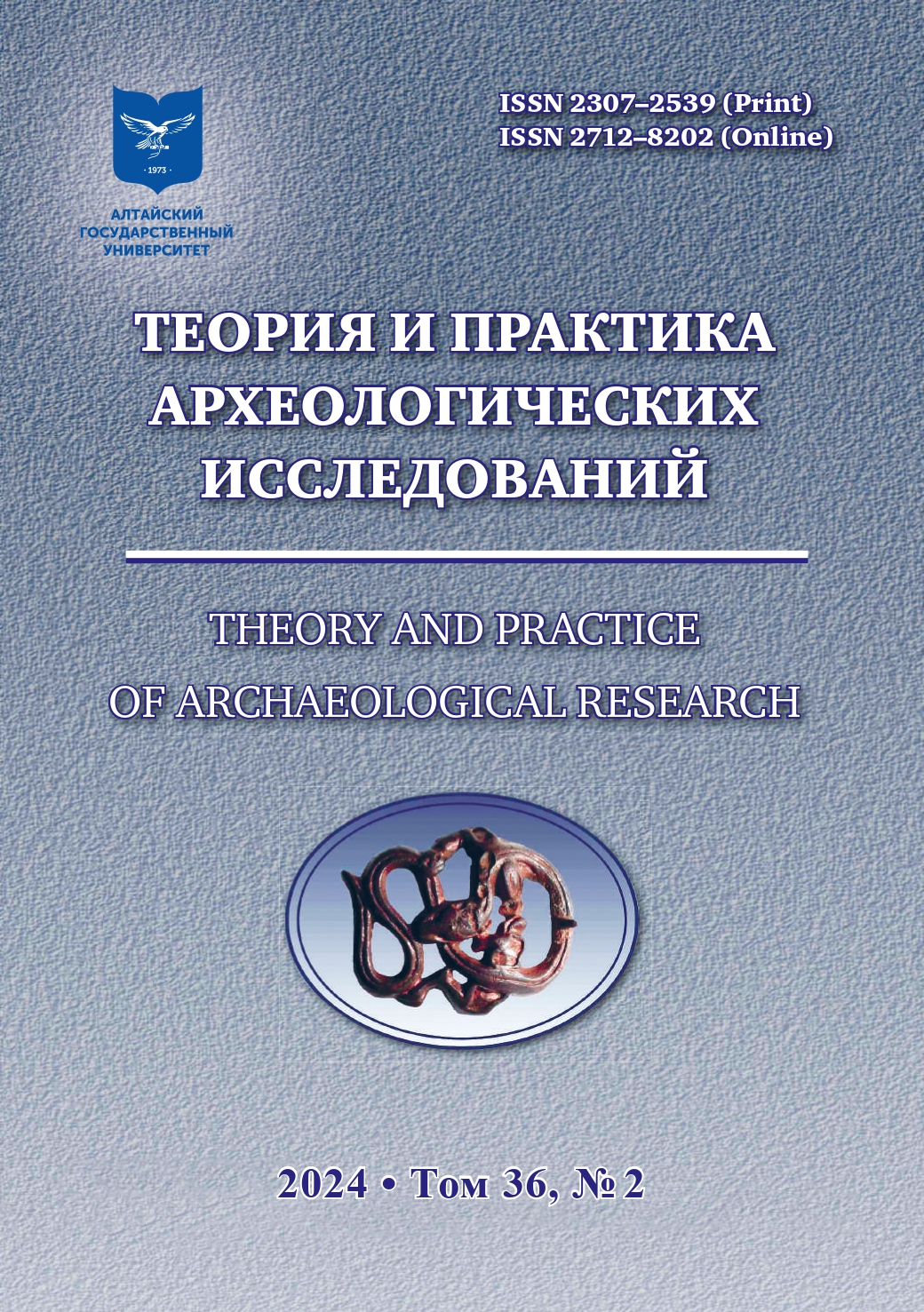SARGARINSKO-ALEKSEEVSKAYA CERAMICS OF THE KULUNDA SETTLEMENTS (Preliminary Results of the Study)
Abstract
The paper presents a generalization of the results of a comprehensive study of Sargarinsko-Alekseevskaya ceramics from the settlements of the Kulunda steppe: Rublevo-VI, Burla-3, Zharkovo-3, Kalinovka-II. It has been established that the basis of the ceramic series is pots. The ornament is mainly located on the shoulders, less often on the neck of a pots. Seven methods of decoration and 73 types of ornamental motifs has been recorded. Compositional patterns often consist of only one motif, one motif repeated three or more times, or two different motifs. A comparative analysis of the forms and ornamentation of the collections of individual monuments in the region made it possible to identify common and individual features of the complexes. The firsts include the shapes of vessels, their similar percentages, common motifs, and the relative simplicity of ornamental compositions. The seconds includes the peculiarities of placing the ornament in the zones of the vessels and the ornamentation techniques. A generalization of the results of a technical and technological study of ceramics showed a similarity in the ferruginous degree of the raw materials used and the presence of recipes that included both gruss and fireclay. The differences between the Kulunda sites are associated with the degree of plasticity of the raw materials and the ratio of the molding mass recipes. As a result of comparison of the obtained data with the Sargarinsko-Alekseevsky materials from the settlements of Central Kazakhstan, their similarity with the ceramics of the studied region in terms of external features (shape and ornament) was established. However, technical and technological analysis data show differences between regions. The identified features indicate the specificity of the process of interaction between regional populations and migrations.Downloads
Metrics
No metrics found.
References
Bejsenov A.Z., Loman V.G. Ancient Settlements of Central Kazakhstan. Almaty : Inzhu-Marzhan, 2009. 264 p. (In Russ.)
Varfolomeev V.V., Loman V.G., Evdokimov V.V. Kent is a Bronze Age city in the Center of the Kazakh Steppes. Astana : Izd. gr. KazNII kul’tury, 2017. 338 p. (In Russ.)
Evdokimov V.V. Settlement of the Bronze Age Ust-Kenetai. In: Questions of Archaeology, Ethnography of Central Kazakhstan. Karaganda : Izd-vo KarGU, 1982. Pp. 3–20. (In Russ.)
Evdokimov V.V., Loman V.G. Settlement Kopa-1. In: Questions of Archaeology, Ethnography of Central Kazakhstan. Karaganda : Izd-vo KarGU, 1982. Pp. 20–41. (In Russ.)
Zdanovich S.Ya. Ceramics of the Sargarin Culture. In: Bronze Age of the Ural-Irtysh Interfluve. Chelyabinsk : Izd-vo Bashkirskogo un-ta, 1984. Pp. 79–96. (In Russ.)
Ivanov G.E. Ceramic complex of the settlement of Suslovo-1. In: Arid zone of the south of Western Siberia in the Bronze Age. Barnaul : Izd-vo Alt. un-ta, 2004. Pp. 49–56. (In Russ.)
Kiryushin Yu.F., Ivanov G.E., Udodov V.S. New Materials of the Late Bronze Age of the Forest-Steppe Altai. In: Problems of Archaeology and Ethnography of Southern Siberia. Barnaul : Izd-vo Alt. un-ta, 1990. Pp. 104–128. (In Russ.)
Loman V.G. Features of Pottery Technology of the Late Bronze Age of Central Kazakhstan. Kratkie soobshcheniya Instituta arheologii = Brief Reports of the Institute of Archaeology. 1991;203:47–53. (In Russ.)
Loman V.G. Imported ceramics in the Kent settlement. Samarskij nauchnyj vestnik = Samara Scientific Bulletin. 2015;4(13):71–80. (In Russ.)
Loman V.G. Ceramics of the Sargarinsko-Alekseevsky Burial Ground Karatugai. Teoriya i praktika arheologicheskih issledovanij = Theory and Practice of Archaeological Research.2019;3(27):113–123. (In Russ.)
Papin D.V., Loman V.G., Stepanova N.F., Fedoruk A.S. Results of Technical and Technological Analysis of the Ceramic Complex of the Late Bronze Age Settlement Rublevo VI. Teoriya i praktika arheologicheskih issledovanij = Theory and Practice of Archeological Research. 2015;2(12):115–143. (In Russ.)
Papin D.V., Fedoruk A.S., Loman V.G., Stepanova N.F. Ceramic Complex of the Late Bronze Age Settlement Zharkovo-3. Teoriya i praktika arheologicheskih issledovanij = Theory and Practice of Archaeological Research. 2016;3(15):102–125. (In Russ.)
Papin D.V., Fedoruk A.S., Loman V.G., Stepanova N.F. Stuffed Ceramics of the Late Bronze Epoch of the Burla-3 Settlement. Teoriya i praktika arheologicheskih issledovanij = Theory and Practice of Archeological Research. 2021;2(33):175–192. (In Russ.)
Sitnikov S.M. Sargarin-Alekseevskaya culture of forest-steppe and steppe Altai: abstract. dis. ... Cand. Hist. Sciences. Barnaul, 2002. 21 p. (In Russ.)
Sitnikov S.M. Culture of the Sargarin-Alekseevsky Population of the Forest-Steppe and Steppe Altai. Barnaul : AltGPU, 2015. 254 p. (In Russ.)
Udodov V.S. The Age of Developed and Late Bronze Ages of Kulunda: abstract. dis. ... Cand. Hist. Sciences. Barnaul, 1994. 21 p. (In Russ.)
Fedoruk A.S. Ethnocultural interaction of the ancient population of the steppe Ob-Irtysh region in the Late Bronze Age: abstract. dis. ... Cand. Hist. Sciences. Barnaul, 2006. 23 p. (In Russ.)
Fedoruk A.S. Ceramics of the “Dongal type” in materials from the monuments of the steppe and forest-steppe Altai. Arheologiya Kazahstana = Archeology of Kazakhstan. 2023;3(21):32–47. (In Russ.)
Fedoruk A.S., Ivanov G.E., Stepanova N.F. Dongal Type of Ceramic from the Kalinovka-II Settlement (Forest-steppe Altai). In: Problems of Archaeology, Ethnography, Anthropology of Siberia and Adjacent Territories. Vol. XXVIII. Novosibirsk : Izd-vo In-ta arheologii i etnografii SO RAN, 2022. Pp. 778–786. (In Russ.)
Fedoruk A.S., Ivanov G.E., Stepanova N.F. Late Bronze Age Sargarinsko-Alekseevskaya ceramics of the Kalinovka-II settlement (forest-steppe Altai). Teoriya i praktika arheologicheskih issledovanij = Theory and Practice of Archeological Research. 2023;35(1):160–181. (In Russ.)
Shamshin A.B., Izotkin S.L., Sitnikov S.M. Settlement Zharkovo-1. Vestnik arheologii, antropologii i etnografii = Bulletin of Archaeology, Anthropology and Ethnography. 2002;4:106–113. (In Russ.)
Copyright (c) 2024 А.С. Федорук

This work is licensed under a Creative Commons Attribution 4.0 International License.
Theory and Practice of Archaeological Research is a golden publisher, as we allow self-archiving, but most importantly we are fully transparent about your rights.
Authors may present and discuss their findings ahead of publication: at biological or scientific conferences, on preprint servers, in public databases, and in blogs, wikis, tweets, and other informal communication channels.
Theory and Practice of Archaeological Research allows authors to deposit manuscripts (currently under review or those for intended submission to ABS) in non-commercial, pre-print servers such as ArXiv.
Authors who publish with this journal agree to the following terms:
- Authors retain copyright and grant the journal right of first publication with the work simultaneously licensed under a Creative Commons Attribution License (CC BY 4.0) that allows others to share the work with an acknowledgement of the work's authorship and initial publication in this journal.
- Authors are able to enter into separate, additional contractual arrangements for the non-exclusive distribution of the journal's published version of the work (e.g., post it to an institutional repository or publish it in a book), with an acknowledgement of its initial publication in this journal.
- Authors are permitted and encouraged to post their work online (e.g., in institutional repositories or on their website) prior to and during the submission process, as it can lead to productive exchanges, as well as earlier and greater citation of published work (See The Effect of Open Access).








2.jpg)




